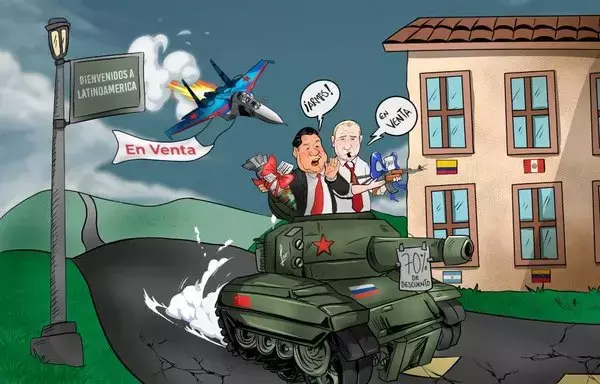Security
Latin America loses interest in accident-prone, hard-to-repair Russian weapons
A string of accidents in Latin America and a lack of assistance and maintenance have raised concerns over Russian-made weapons.
![Investigators, members of civil protection and firefighters observe the remains of a Russian-made Mi-17 helicopter belonging to the Bolivian military that crashed in Barquisimeto, Venezuela, on February 2022. A string of accidents in Latin America and a lack of assistance and maintenance have raised concerns over Russian-made weapons. [Artemio Sequera/AFP]](/gc4/images/2023/06/30/42788-mi_crash-600_384.webp)
By Juan Camilo Escorcia |
BOGOTA -- Over the past two decades, Venezuela has emerged as the leading purchaser of Russian arms in Latin America.
Yet it has also experienced the highest rate of Russian-made helicopter accidents in the region.
Seven accidents involving the Mi-17 helicopter fleet of the Venezuelan Bolivarian National Armed Forces (FANB) have been registered since 2008, resulting in 47 deaths. The year 2022 was the worst, with four accidents and eight deaths.
The causes of the accidents were never officially disclosed.

A Russian Mi-17 helicopter was also responsible for the deadliest air accident in the history of the Colombian army. In June 2016, the aircraft crashed in a mountainous area in the center of the country, killing five crew members and 12 other military personnel.
In a span of less than eight months, two accidents involving Mi-17 helicopters in the Andes and the Amazon rainforest claimed the lives of 10 Peruvian military personnel.
The string of accidents involving Russian Mi-17 helicopters in Latin America has raised concerns about the low quality and obsolescence of Russian arms.
In addition to the accidents, difficulty of maintenance is a problem, say several reports.
Imports' collapse
An article published by the state-owned Russian news agency Sputnik on January 23 highlighted that eight countries in Latin America obtained Russian weaponry between 2000 and 2021.
"Venezuela has acquired the most weaponry from Moscow of any Latin American country," ranging from air defense systems to combat helicopters and guided bombs, according to Sputnik, which has been sanctioned by the European Union for spreading misinformation about the Russian invasion of Ukraine.
The exact quantity of weaponry is unknown, but it is estimated to be worth billions of dollars.
The publication, based on reports from the Stockholm International Peace Research Institute (SIPRI), also states that Nicaragua was the second largest purchaser of Russian weapons in Latin America between 2000 and 2021. The country acquired "at least one helicopter and 50 T-72B tanks, among other weapons".
Peru followed, buying more than 32 Russian helicopters and more than 200 missiles over the course of those 21 years.
"Mexico acquired at least 30 air defense systems and nine Russian helicopters," while Cuba bought a MiG-29 fighter jet and Uruguay bought "48 Vodniks, a highly mobile multipurpose Russian military vehicle." Argentina purchased "a pair of Russian helicopters, Mi-8MT/Mi-17 model," and Colombia bought six.
However, a BBC News publication from April 2022 revealed that sales of Russian military products to Latin America plummeted between 2017 and 2021.
The publication attributed the decline to economic reasons, as well as the obsolescence of Russian military equipment and difficulty in repairing it.
"In the last five years, there has been a very sharp decline in Russian arms sales to Latin America. In fact, there is almost nothing," Siemon T. Wezeman, a senior researcher at SIPRI's Arms Transfers Program, told BBC.
According to the BBC, the first decade of the 21st century saw a commercial boom in South America, with strong foreign exchange earnings that allowed countries in the region to equip their armed forces. In fact, "South America was the region in the world where military spending grew the most in 2010, with Brazil leading this phenomenon."
The commercial boom in South America ended abruptly in 2014, when the collapse of commodity exports led to a fiscal squeeze for the region. This, coupled with the absence of conflicts between countries in the region, resulted in a cutback in weapon purchases.
Consequently, between 2017 and 2021, arms imports by South American states reached their lowest level in 50 years, the BBC said, citing SIPRI data.
Despite the decline in arms imports, the BBC stressed that Latin American countries continued to buy and receive military equipment from several other countries, including the United States, Sweden, Italy, France and South Korea while they "stopped buying from Russia."
Other reasons for decline in demand
Demand for Russian weapons by some states is expected to keep falling because of "trade sanctions imposed on Russia and increasing pressure" from the European Union, United States and its allies not to buy Russian arms, according to Wezeman.
Wezeman added that the contraction in Russian arms exports would also stem from the Kremlin's need "to give priority to the supply of its armed forces" participating in the invasion of Ukraine.
The Russian military has suffered heavy losses in Ukraine, and the Kremlin is now focusing on replenishing its stocks of weapons and ammunition.
Another recent crash in Latin America highlighted the dangers of buying Russian.
On June 16, a Russian Mi-17 helicopter crashed in Temamatla, a few kilometers south of Mexico City, killing two Mexican military personnel. This was the fourth accident involving Russian helicopters in Mexico since 2019, and it is unlikely to be the last in Latin America.